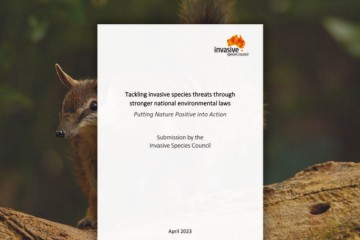Australia’s national environment law has a missing letter – and that small omission tells a big story about why our wildlife keeps disappearing.
The Environment Protection and Biodiversity Conservation Act 1999 (EPBC Act) is missing an ‘s’. That sounds trivial, but its absence has hobbled a key function of the law, delaying action on some of the most destructive threats to our wildlife.
And even now, as the government’s long-awaited reforms of the EPBC Act are about to be introduced to parliament, we understand the elusive ‘s’ is still nowhere to be found. Environment Minister Murray Watt has his mind on threats other than those to nature.
Amidst all the kerfuffle about whether Labor will do a deal with the Coalition or the Greens to pass EPBC amendments, the story of the missing ‘s’ deserves to be told. The failure to fix a simple but cascading design flaw is symptomatic of an environmental malaise – a lack of commitment to deal systematically with the mega-threats wiping out wildlife.
One of the EPBC Act’s central jobs is to identify and list big dangers to native plants, animals and ecological communities – known as key threatening processes – and to develop threat abatement plans to eliminate or reduce the threats. Because Australia has multitudes of invasive species hunting, trampling, diseasing and outcompeting native wildlife, they dominate the listed threats. They have also been Australia’s major driver of animal extinctions and are our most expensive land management problem.
Despite this, some 16 years ago, the environment department decided to stop accepting new nominations for invasive threats. They argued it was too resource-intensive to assess each one individually. Under the clunky EPBC processes, it would take decades to do this comprehensively.
Their sensible workaround was to list all invasive species under a single umbrella – novel biota – and then prioritise those needing detailed plans. It sounded efficient until someone, a few years after the listing, noticed a problem: the law says a minister can make a threat abatement plan, not plans.
That missing ‘s’ means only one plan can legally be made for the entire class of invasive animals, weeds and diseases (other than those separately listed as threats).
Imagine if Medicare allowed only one treatment plan for all cancers. The result would be paralysis – and that’s exactly what happened here.
Because of the novel biota listing, no invasive species has been listed as a key threatening process since 2010. Nominations for serious extinction-and-degradation drivers – from myrtle rust to invasive fish and destructive weeds – have been rejected or shelved.
One casualty was our 2011 nomination of feral deer. If it had been accepted and acted on back then, Australia’s rapidly intensifying deer problem would be less severe and expensive.
The current rush to pass EPBC reforms was precipitated by Treasurer Jim Chalmers’ push on productivity. Yet, what could deliver more bang for buck than a simple one-line amendment to expedite action on mega-threats to nature?
The conception of productivity driving the government’s EPBC reform agenda, focused only on developments, neglects the gains that could be made by creating a more productive system for preventing and mitigating the threats that wipe out wildlife.
These environmental mega-threats are often also major threats to industries such as agriculture and tourism. But conservation itself needs a stronger focus on productivity. Unless we address the causes of decline more systematically, our already 2100-strong national list of threatened species will inevitably continue to grow. The government well understands that, for health, it is most productive to focus on preventing illness, rather than just treating the sick.
It will be the opposite of productive – and an environmental travesty – if we have to wait another decade to find the missing ‘s’.
If Minister Watt needs help locating it – it’s between ‘r’ and ‘t’. It’s also the first letter of solution, species and save.
Dr Carol Booth, Invasive Species Council Policy Director







